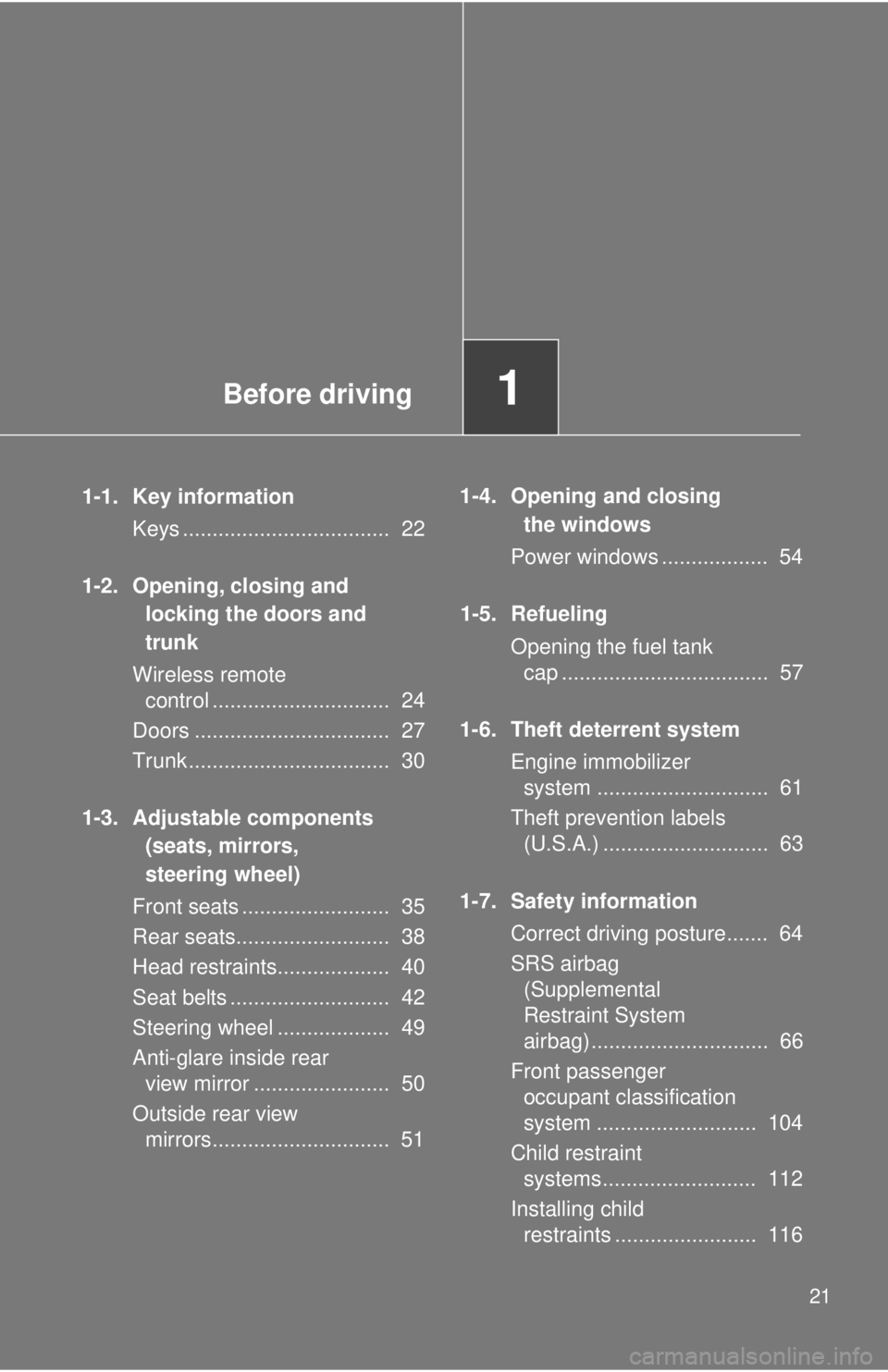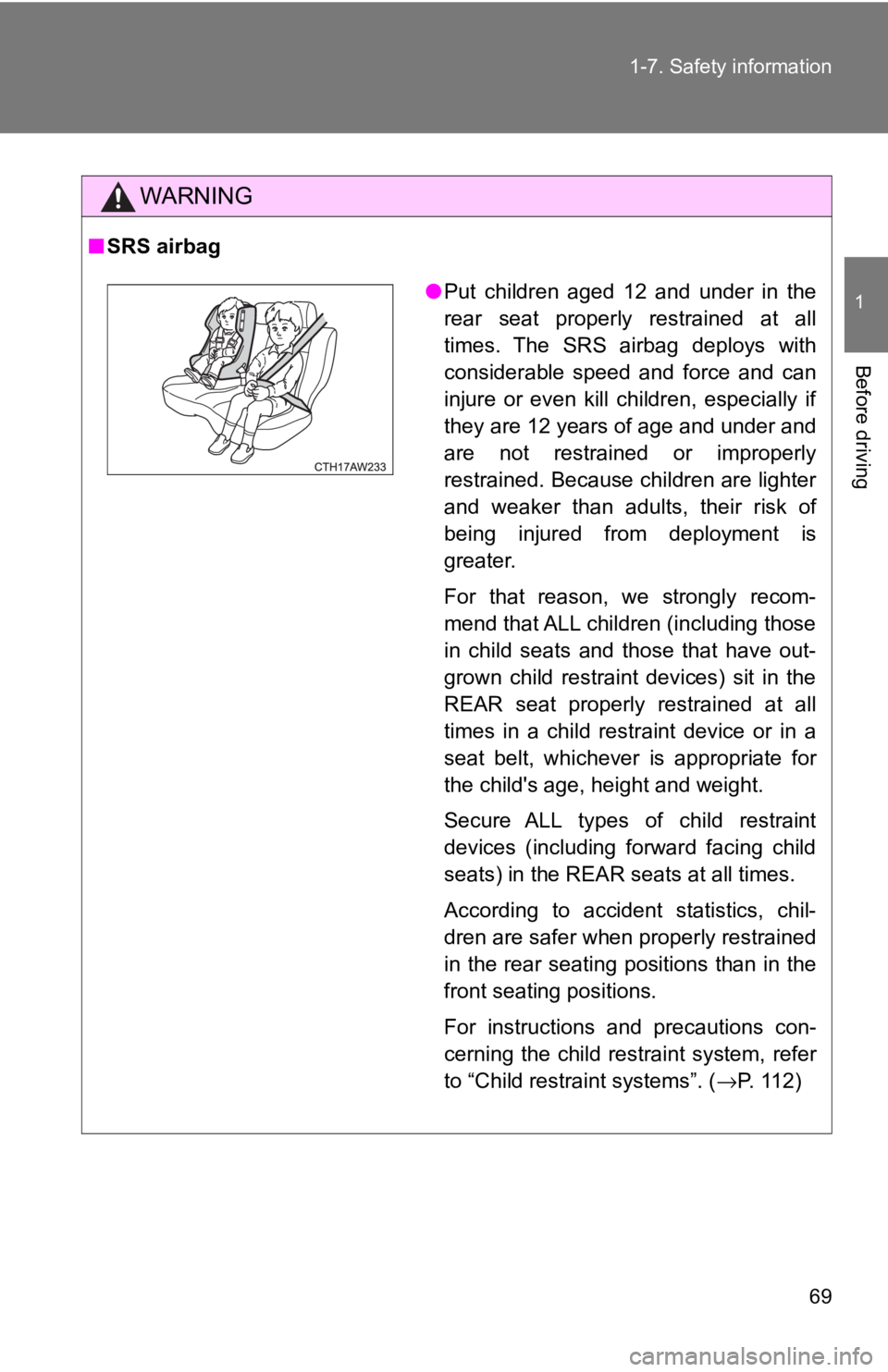2017 TOYOTA 86 child restraint
[x] Cancel search: child restraintPage 2 of 428

TABLE OF CONTENTS Index
21-1. Key information
Keys ..................................... 22
1-2. Opening, closing and
locking the doors and
trunk
Wireless remote control ....... 24
Doors.................................... 27
Trunk .................................... 30
1-3. Adjustable components
(seats, mirrors,
steering wheel)
Front seats ........................... 35
Rear seats ............................ 38
Head restraints ..................... 40
Seat belts ............................. 42
Steering wheel ..................... 49
Anti-glare inside rear
view mirror.......................... 50
Outside rear view mirrors ..... 51
1-4. Opening and closing
the windows
Power windows .................... 54
1-5. Refueling
Opening the fuel tank cap .... 57
1-6. Theft deterrent system
Engine immobilizer
system ................................ 61
Theft prevention labels
(U.S.A.) .............................. 63 1-7. Safety information
Correct driving posture ......... 64
SRS airbag
(Supplemental Restraint
System airbag) ................... 66
Front passenger occupant
classification system ......... 104
Child restraint systems ....... 112
Installing child restraints ..... 116
2-1. Driving procedures
Driving the vehicle .............. 128
Engine (ignition) switch....... 142
Automatic transmission ...... 145
Manual Transmission ......... 152
Turn signal lever ................. 155
Parking brake ..................... 156
Horn .................................... 157
2-2. Instrument cluster
Gauges and meters ............ 158
Indicators and warning
lights ................................. 161
Multi-information display ..... 165
2-3. Operating the lights and
windshield wipers
Headlight switch ................. 172
Windshield wipers and
washer .............................. 1761
Before driving
2
When driving
Page 8 of 428

8Pictorial index Interior
Power outlet P. 230Head restraints P. 40
Seat belts P. 42
SRS front passenger
airbag P. 66
Cup holders
Console tray P. 225
P. 225
SRS side airbags P. 66
Front seats P. 35
Glove box P. 223SRS curtain shield
airbags P. 66
Child restraint
anchor brackets P. 116
Page 21 of 428

Before driving
1
211-1. Key information
Keys ................................... 22
1-2. Opening, closing and
locking the doors and
trunk
Wireless remote
control .............................. 24
Doors ................................. 27
Trunk .................................. 30
1-3. Adjustable components
(seats, mirrors,
steering wheel)
Front seats ......................... 35
Rear seats.......................... 38
Head restraints................... 40
Seat belts ........................... 42
Steering wheel ................... 49
Anti-glare inside rear
view mirror ....................... 50
Outside rear view
mirrors.............................. 51 1-4. Opening and closing
the windows
Power windows .................. 54
1-5. Refueling
Opening the fuel tank
cap ................................... 57
1-6. Theft deterrent system
Engine immobilizer
system ............................. 61
Theft prevention labels
(U.S.A.) ............................ 63
1-7. Safety information
Correct driving posture....... 64
SRS airbag
(Supplemental
Restraint System
airbag).............................. 66
Front passenger
occupant classification
system ........................... 104
Child restraint
systems.......................... 112
Installing child
restraints ........................ 116
Page 44 of 428

441-3. Adjustable components (s eats, mirrors, steering wheel)
■ Emergency locking retractor (ELR)
The retractor will lock the belt during a sudden stop or on impact. It may also
lock if you lean forward too quickly. A slow, easy motion will allow the belt to
extend so that you can move around fully.
■ Automatic locking retractor (ALR)
When a passenger's shoulder belt is completely extended and then
retracted even slightly, the belt is locked in that position and cannot be
extended. This feature is used to hold the child restraint system (CRS) firmly.
To free the belt again, fully retract the belt and then pull the belt out once
more. ( → P. 116)
■ Child seat belt usage
The seat belts of your vehicle are principally designed for persons of adult
size.
● Use a child restraint system appropriate for the child, until the child
becomes large enough to properly w ear the vehicle's seat belt.
( → P. 11 2 )
● When the child becomes large enough to properly wear the vehicle's seat
belt, follow the instructions on P. 42 regarding seat belt usage.
■ Seat belt pretensioners
● Seatbelt pretensioners are not designed to activate in a rear impact or
minor frontal or side impact.
● The following four components operate simultaneously when the vehicle
is involved in a rollover accident.
• Seat belt pretensioner for driver
• Seat belt pretensioner for front passenger
• SRS curtain shield airbag for driver’s seat side
• SRS curtain shield airbag for front passenger’s seat side
Page 46 of 428

461-3. Adjustable components (s eats, mirrors, steering wheel)
WARNINGObserve the following precautions to reduce the risk of injury in the event of
sudden braking, sudden swerving or an accident.
Failure to do so may cause death or serious injury.
■ Wearing a seat belt
● Ensure that all passengers wear a seat belt.
● Always wear a seat belt properly.
● Each seat belt should be used by one person only. Do not use a seat belt
for more than one person at once, including children.
● Toyota recommends that children be seated in the rear seat and always
use a seat belt and/or an appropriate child restraint system.
● To achieve a proper seating position, do not recline the seat more than
necessary. The seat belt is most effective when the occupants are sitting
up straight and well back in the seats.
● Do not wear the shoulder belt under your arm.
● Always wear your seat belt low and snug across your hips.
■ Pregnant women
Obtain medical advice and wear the seat
belt in the proper way. ( → P. 42)
Women who are pregnant should position
the lap belt as low as possible over the
hips in the same manner as other occu-
pants. Extend the shoulder belt com-
pletely over the shoulder and position the
belt across the chest. Avoid belt contact
over the rounding of the abdominal area.
If the seat belt is not worn properly, not
only the pregnant woman, but also the
fetus could suffer death or serious injury
as a result of sudden braking or a colli-
sion.
Page 69 of 428

691-7. Safety information
1
Before driving WARNING■ SRS airbag
● Put children aged 12 and under in the
rear seat properly restrained at all
times. The SRS airbag deploys with
considerable speed and force and can
injure or even kill children, especially if
they are 12 years of age and under and
are not restrained or improperly
restrained. Because children are lighter
and weaker than adults, their risk of
being injured from deployment is
greater.
For that reason, we strongly recom-
mend that ALL children (including those
in child seats and those that have out-
grown child restraint devices) sit in the
REAR seat properly restrained at all
times in a child restraint device or in a
seat belt, whichever is appropriate for
the child's age, height and weight.
Secure ALL types of child restraint
devices (including forward facing child
seats) in the REAR seats at all times.
According to accident statistics, chil-
dren are safer when properly restrained
in the rear seating positions than in the
front seating positions.
For instructions and precautions con-
cerning the child restraint system, refer
to “Child restraint systems”. ( → P. 112)
Page 73 of 428

731-7. Safety information
1
Before driving Toyota advanced frontal airbag system
Your vehicle is equipped with a To yota advanced frontal airbag sys-
tem that complies with the new advanced frontal airbag requirements
in the amended Federal Motor Vehicle Safety Standard (FMVSS) No.
208.
The Toyota advanced frontal airbag system automatically determines
the deployment force of the driver’s SRS frontal airbag at the time of
deployment as well as whether or not to activate the front passen-
ger’s SRS frontal airbag and, if acti vated, the deployment force of the
SRS frontal airbag at the time of deployment.
Your vehicle has warning labels on the driver’s and front passenger’s
sun visors beginning with the phrase “EVEN WITH ADVANCED AIR
BAGS” and a tag attached to the gl ove box lid beginning with the
phrase “Even with Advanced Air Bags”. Make sure that you carefully
read the instructions on the warning labels and tag.
Always wear your seat belt. The Toyota advanced frontal airbag sys-
tem is a supplemental restraint system and must be used in combina-
tion with a seat belt. All occupant s should wear a seat belt or be
seated in an appropriate child restraint system.
The driver’s SRS frontal airbag is st owed in the center portion of the
steering wheel. The front passenger’s SRS frontal airbag is stowed
near the top of the dashboard under an “SRS AIRBAG” mark.
In a moderate to severe frontal collision, the following components
deploy.
● SRS frontal airbag for driver
● SRS frontal airbag for front passenger
These components supplement the s eat belts by reducing the impact
to the occupant’s head and chest.
Page 76 of 428

761-7. Safety information
Also, if luggage or electronic devices are placed on the front passenger’s
seat, this may adversely affect the ability of the system to determine deploy-
ment. This may prevent the front passenger’s frontal airbag ON and OFF
indicators from working properly. Check that the indicators work properly.
When the OFF indicator turns off and the ON indicator illuminates, the front
passenger’s frontal airbag may deploy during a collision. Remove luggage
and electronic devices from the front passenger’s seat.
NOTE
This device complies with Part 18 of the FCC Rules. This device may cause
interference. If this device causes interference, consult the nearest Toyota
dealer. Also, for maintenance of the system, consult the nearest Toyota
dealer.
■ Conditions in which front passenger’ s SRS frontal airbag is not acti-
vated
The front passenger’s SRS frontal airbag will not be activated when any of
the following conditions are met regarding the front passenger’s seat:
● The seat is empty.
● The seat is equipped with an appropriate child restraint system and an
infant is restrained in it.
● The occupant changed their posture after the occupant load is judged.
● The front passenger’s occupant classification system is malfunctioning.
WARNING
When the front passenger’s seat is occupied by an infant in an appropriate
child restraint system, observe the following precautions. Failure to do so may
interfere with the proper operation of the occupant classification system, acti-
vating the front passenger’s SRS frontal airbag even though that seat is occu-
pied by the infant in the child restraint system.
● Do not place any article (including electronic devices) on the seat other than
the infant in the child restraint system.
● Do not place more than one infant in the child restraint system.